Malus domestica
I have to admit, when somebody says, “Imagine a tree,” I envision an apple tree, and when they say “Think about a fruit,” my mind jumps to apples right away. It only makes sense that I think growing apple trees is a gardening high art.
Part of that love and appeal comes from being raised on an old apple orchard. Back then I mostly climbed the trees, ate the fruit, and sadly, watched as the last survivors slowly succumbed to old age.
Nowadays I get to plant new trees often and tend to those that are producing fruit regularly.
Regular research and learning gives me an even better grasp on what it takes to grow an apple tree, and that’s just what we’re going to take a look at today.
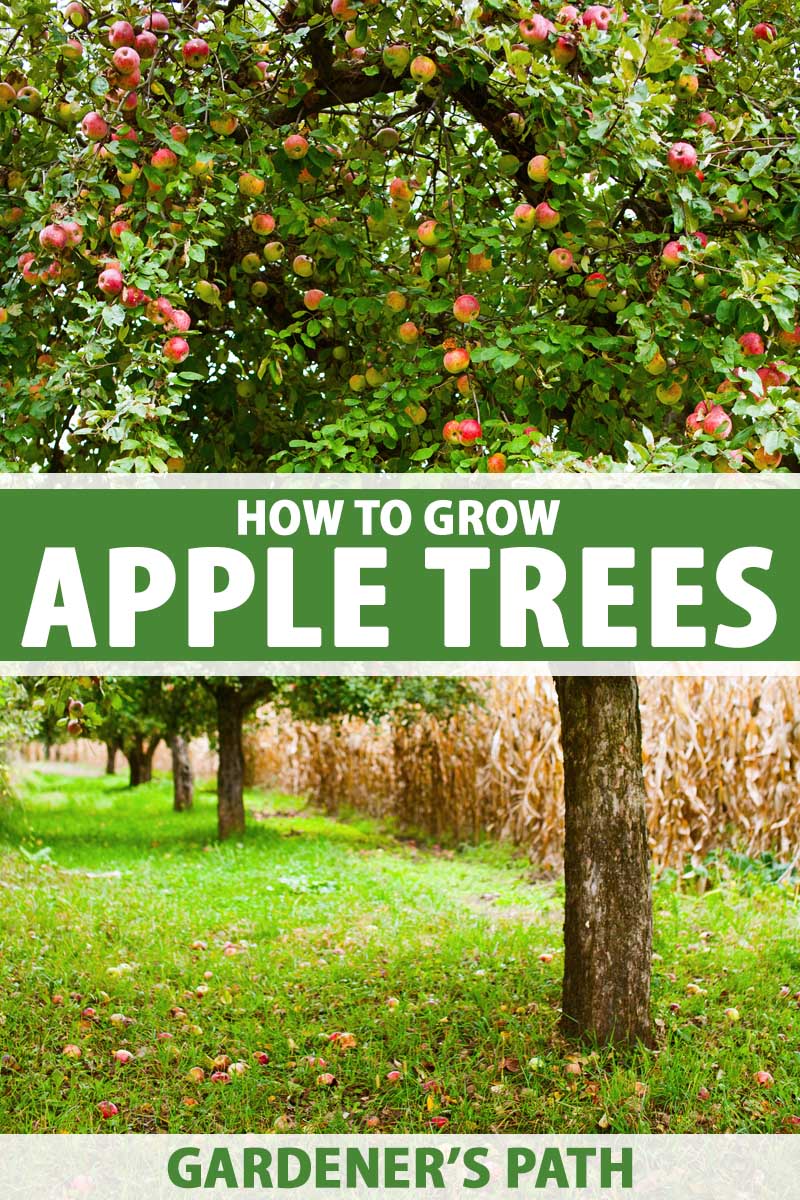
We link to vendors to help you find relevant products. If you buy from one of our links, we may earn a commission.
Growing apple trees may seem daunting, but it’s a rewarding investment. Let’s get started.
Guide to Growing Apple Trees
What These Trees Need
Right up front: lots of sun and lots of drainage!
Like most fruit-producing plants, apples want as much sun as they can get to grow their best. They’ll need at least six hours of sun each day, preferably in a location where they are spared the worst of the summertime late-afternoon sun.
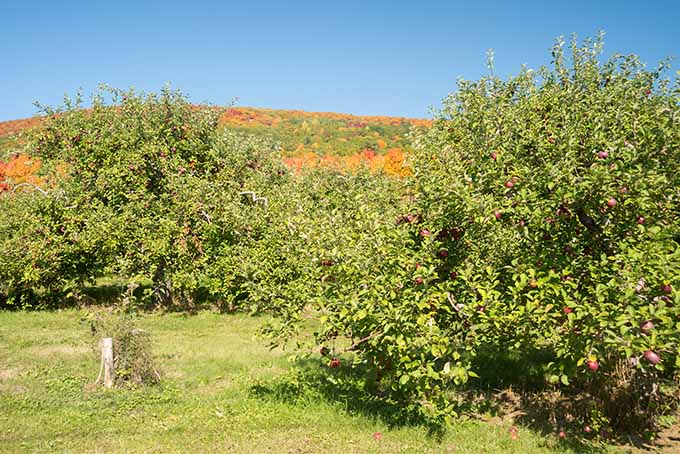
Apple trees will do their best when they are planted in well-drained soil that doesn’t get too wet. They should never be planted in low-lying or wet patches; that’s a job for willows and bald cypress!
An ideal location would be a northern or eastern slope, with the apple tree planted near the top in a sunny location. You’ve got your sunshine and your drainage, and that’s a pretty good start.
A Bit of Room to Grow
You’ll find two types of apple trees: the dwarf variety and the full-size variety.
Dwarf apple trees tend to grow to a height of about four to eight feet, while the full-size trees grow significantly larger, up to about twenty or thirty feet tall. There are advantages and disadvantages to either size.
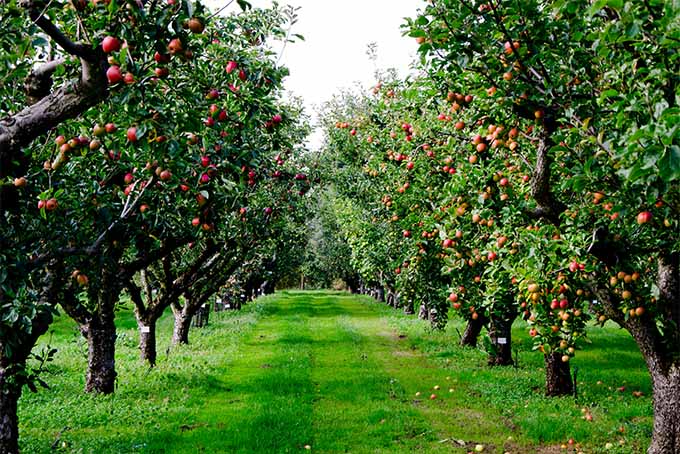
Dwarf trees are smaller and more contained. Many are ideal for espalier-style growing.
Their fruit production is typically small, but they take up far less room in the backyard than larger cultivars. You can also fit more trees in one area, providing a wider array of tastes and longer periods of fruit availability. They’re easier to harvest from too.
Unfortunately, dwarf trees tend to have weaker root systems. They’re more susceptible to being blown over during strong storms, and can even topple over under a heavy fruit crop. Be sure to grow these dwarf trees against a fence or with adequate support.
The full-size trees don’t have the same issues with their roots, but they are larger and thus demand more space. In exchange for a significant yield, you’ll need to use ladders and pole clips to prune these trees, and a fruit picker to harvest most of the apples.
Comparatively, dwarf apple trees are ideal for a casual gardener or somebody who isn’t inclined to do extensive pruning. Full-size trees are for the more serious grower, or the one with the space and inclination to work on these larger plants.
How Far Apart Do They Need to Be?
Good question. Every tree has different spacing needs, but in general, dwarf trees should be planted four to eight feet apart. Full-size trees need distances of fifteen to eighteen feet in between to provide enough space to grow.
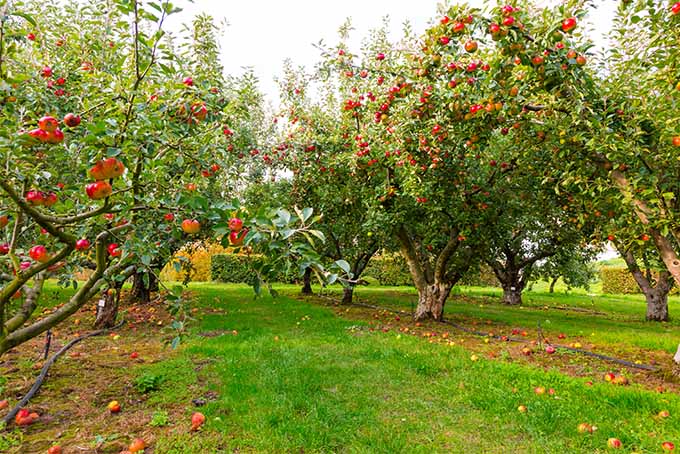
In order to pollinate each other, plant no more than 50 feet apart.
It Takes Two to Make a Thing Grow Right
Ah, who doesn’t enjoy a nice ’80s hip-hop reference?
Most apple trees can’t produce fruit on their own and require cross-pollination from another tree. The trick to this is, not all trees will work.
So which ones can you select? I’ll include a short list of what pollinates what here.
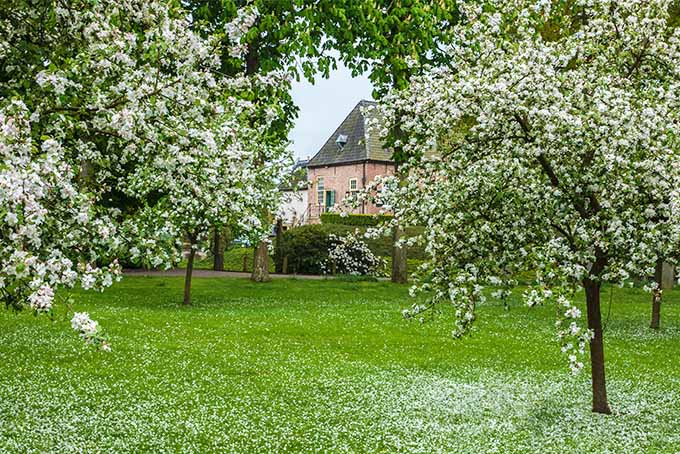
Apples are divided into seven flowering groups based on when they bloom. Some examples of cultivars in the various flowering groups are listed below, but this is by no means a comprehensive list.
For a tree to pollinate another, they must be in bloom at the same time. This is an important factor for picking which plants you’ll place in your yard.
Additionally there are species known as “triploids.” These trees have three chromosomes and require two additional pollen sources to provide fruit. Planting a triploid plant requires at least three trees to be planted together to provide pollen for the triploid.
Or, consider one of the self-fruiting species. These trees can pollinate a triploid by themselves.
-
-
- Flowering Group 1 (Pollinates groups 1 and 2): Graventstein (triploid), Lord Suffield, Vista Bella
- Flowering Group 2 (Pollinates groups 1, 2, 3): Baker’s Delight, Bismarck, Golden Spire, Idared, Mcintosh, Norfolk Beauty, Washington (triploid)
- Flowering Group 3 (Pollinates groups 2, 3, 4): Acme, Bountiful, Elster, Exquisite, Golden Delicious, Holstein (triploid), Jonagold (triploid), Katy, Saturn
- Flowering Group 4 (Pollinates groups 3, 4, 5): Barnack Beauty, Delicious, Gala, Golden Delicious, Monarch
- Flowering Group 5 (Pollinates groups 4, 5, 6): Coronation, Merton Beauty, William Crump
- Flowering Group 6 (Pollinates groups 5, 6, 7): Bess Pool, Court Pendu Plat
- Flowering Group 7 (Pollinates group 6): Crawley Beauty
-
In general, other fruit-bearing trees that produce flowers at the same time as your apple trees are viable for cross-pollination. It’s always best to cross-pollinate within the same genus, but this could also include crabapples and pears, since they are all pome fruits.
Read more about apple tree pollination here.
Pretty Good, Not Great Soil
Sure, they need ample sun and good drainage, but at least apple trees don’t need rich soil! They tend to do their best in moderate-quality soil, nothing too poor or too rich.
When they are first planted, apple trees don’t need any fertilizing. In fact they don’t need anything by way of nutritional supplementation until they’ve been established for between two and four years. The actual number here depends on the cultivar you’ve chosen, and when your tree starts to produce fruit.
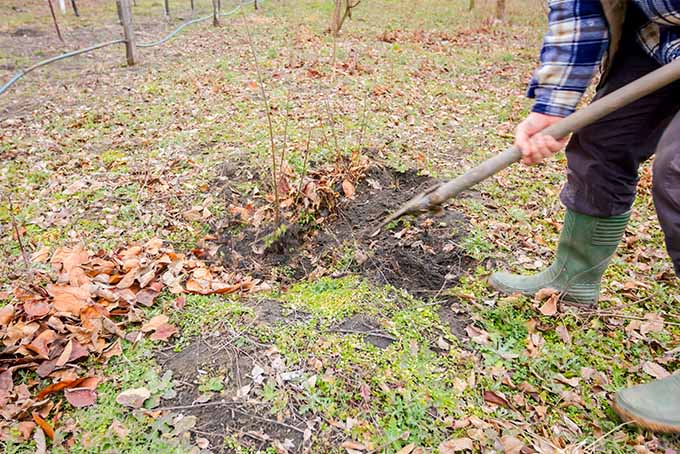
After the tree starts producing fruit in the springtime, you’ll want to provide it with a nitrogen-heavy fertilizer. This is because apples start to gobble up nitrogen in large amounts after fruit production begins.
I’ve had the most experience using Jobe’s Organic Fruit and Citrus Fertilizer and feel comfortable recommending it. Follow the directions on the back for application rates, but remember, we aren’t fertilizing our trees the first year they’re in the ground.

Jobe’s Organics Fruit & Citrus Fertilizer with Biozome
When using fertilizer, I abide by the “just enough” rule. Avoid the temptation to overfeed your plants and fertilize sparingly on an as-needed basis.
It’s highly recommended that you do not fertilize your apple trees after the fourth of July, because any new growth after that date is prone to damage later in the season.
What’s the Drip Line?
The drip line is where the highest density of feeder roots can be found. These are the soft, white roots that seek out nutrients to feed your plant.
The best visual for imagining where the drip line is located is to look at the tree as if it is an umbrella. Everywhere the water drips down from the edges of the umbrella, or tree, is where you can imagine the drip line.
Fertilizing too close to the trunk is ineffectual. Always fertilize in the drip line!
It’s safe to apply a bit of compost sprinkled around the drip line of your apple tree each year in the spring, followed by that nitrogen boost after fruit production begins.
Choosing the Best Option
Your geographic location will dictate what apple trees you are looking to buy. Two types of apple trees exist: hardy, which grow in USDA Hardiness Zones 3 to 5, and long season, which grow in Zones 5 to 8.
You’ll also need to check the “chill hours” for trees you’re considering, and map this against your average climate. Chill hours are the period time per year that an apple tree needs to be in temperatures ranging from 32 to 45°F.
Due to this requirement, you’ll probably have a tough time attempting to grow apples in the extreme south.
Choosing a variety of apple tree that is resistant to pests and diseases is vital to the long-term health of your garden, and it’s also important when it comes to producing fruit.
Jonagold, I Choose You!
Just as important as what will grow where, you’ll need to decide what type of apple you want to harvest. Most often this choice depends on whether you want fruit to eat, or fruit to cook with.
Wondering which is for you? Our sister site Foodal will help you choose the best variety for your purposes!
What About Cider?
Remember the story of Johnny Appleseed? His real name was John Chapman, and he introduced apples across wast swaths of America by spreading their seed, thinking grafting hurt the host plant. As a result, what he planted sometimes grew into new sweet and delicious varieties, but they were often tart “cider apples,” fruit that’s difficult to eat and downright unpalatable out of hand.
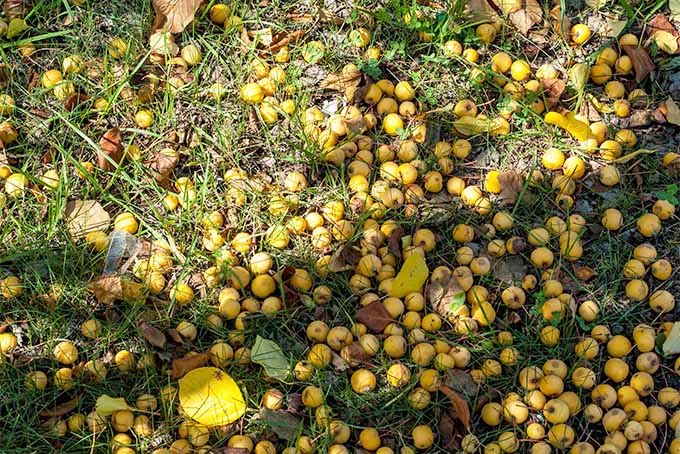
Since apples don’t grow true to seed, only grafted saplings will produce the cultivar you’re looking for one hundred percent of the time. We’ve come full circle today, with specific cider-friendly cultivars available on the market. Several grafted varieties can be purchased to add to your home orchard.
Proper Planting Practices
Planting is the first step we can take to ensuring we’ve got healthy, happy trees. Almost all apple trees are at their best when planted in the spring. But spring can be a tricky season to get a handle on.
Spring is in the Goldilocks zone. The ground shouldn’t be frozen and cold weather should not be expected in the forecast, and yet it also can’t be too hot out. Not too hot, not too cold.

Truper 54-Inch Tru Pro Forged Eye Hoe with 7-Inch Head, Ash Handle
First things first, we remove a patch of grass around the intended planting area. Ideally, this will be a four-foot circle of removed turf and sod. My all-time favorite tool to accomplish this is a grub hoe, like this one that’s available from Amazon. It makes jobs like removing turf a breeze.
The hole you dig should have a diameter at least six inches larger than the pot size, and it should reach down to a depth of between eighteen inches and two feet. We don’t need to add any fertilizer or amendments to the soil unless it’s in really poor shape.
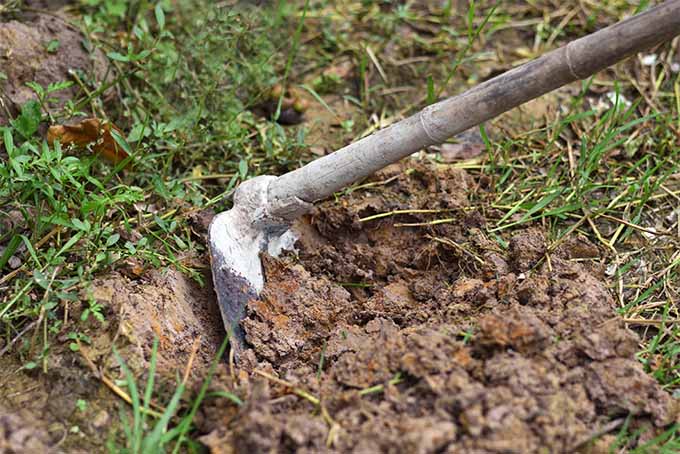
If you purchased a container-grown tree, you’ll want to remove the container and loosen the root ball. Don’t be afraid of slicing through some roots – you aren’t hurting the tree if you do this.
The roots of a container grown tree tend to grow in a circle around the bottom of the container. By slicing through the roots and loosening things up, we encourage roots to grow down in the direction they’re supposed to be going. It’s okay to really loosen up the root ball.
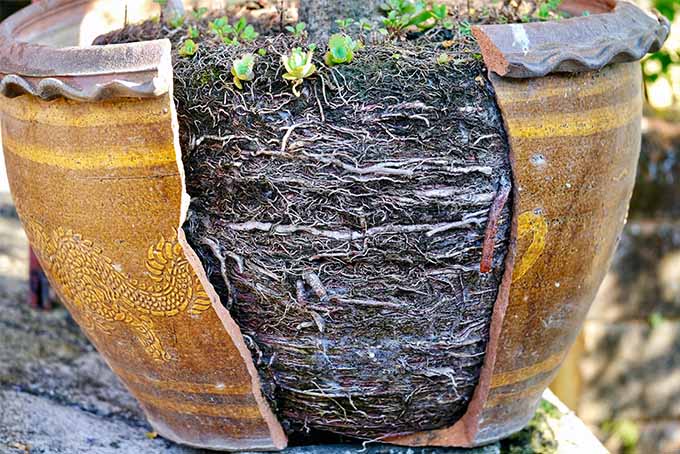
If you purchased a bare root tree, then you don’t need to do this.
Plant the tree in the hole so that it’s about an inch or so above grade, fill the hole back in with soil, and pack it in firmly. The planting area around the tree should be slightly mounded, but don’t worry – this will settle eventually and become flat with the the ground.
It’s safe planting practices to never bury the trunk of any tree. That applies to mulching as well; don’t pile mulch up around the trunk.
Avoid pruning or fertilizing young trees. In the majority of cases, you can get away without pruning or fertilizing the tree until it begins producing fruit.
Be sure to give your young tree plenty of water. Follow the tips in our watering guide to get you started.
Time for a Bit of a Haircut
Whether it’s for fruit production or just a nice looking tree, apples require some regular pruning.
Springtime is the best time of year to prune an apple tree, preferably before it starts to set leaves. The basics of pruning apply when working on apples, but there are other specific points to take into account:
First, I like to make a distinction between structural pruning and maintenance pruning when I hit apple trees.
Structural Pruning
The trees need strong limbs to grow fruit on, so the first thing to eliminate when structurally pruning are weak limbs. The best limb for growing fruit is positioned at a 45° angle from the trunk, or the “ten and two” angles we’re familiar with when keeping our hands on the steering wheel.
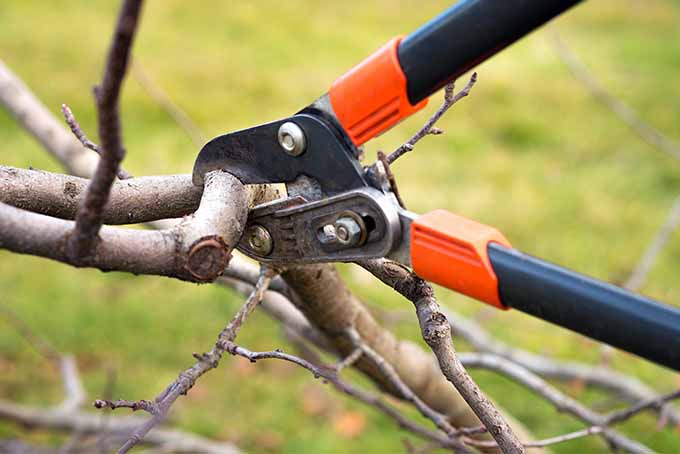
Eliminate weak and dead limbs. The longer a branch produces fruit in terms of years, the more likely it is that this portion will eventually need to be removed. The same goes for any damaged, diseased, or dying wood: cut it off!
Maintenance Pruning
This takes a bit more confidence in your pruning skills.
Right off the bat, you’ll want to remove water shoots. These are the thin, whiplike growths that shoot straight upward. Cut these off aggressively, right to the branch.
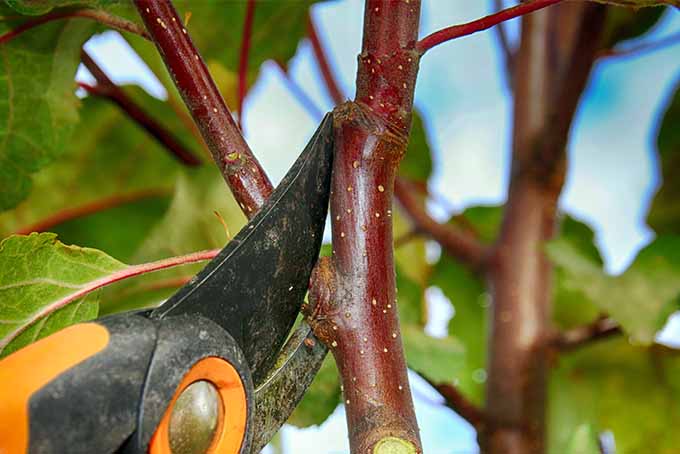
Next up are crossing branches. Have you ever noticed how some branches get turned around and start growing back towards the trunk instead of away from it? Sometimes you’ll have two branches crossing over each other. We want to remove competing branches, and open the tree up for good airflow and better fruit production.
By taking care of these competing branches, we encourage more fruit production on the existing limbs.
Ensuring a Good Harvest
After the fruits begin to develop, you’re going to want to thin them out on the branches. This seems counterintuitive to having a larger harvest, and you may find yourself wondering, “Why the heck am I removing soon-to-be apples?”
Well, imagine the expenditure that goes into producing fruit. A tree can only produce a finite amount of energy for its fruit production. If that energy is spread out over five hundred apples, you’ll get a lot of poorly developed, lackluster fruits.

However, if we remove the weakest fruits, the ones that are smaller and cracked and using up valuable resources, we’ll have a crop of, say, two hundred apples – but they’re all going to be large, healthy, good-tasting fruits.
It’s the same idea behind thinning out your seeds and deadheading spent flower blooms, just on a different playing field.
Once the fruit starts developing and you’re removing the weaker, smaller, or cracked fruits, aim to keep about four inches between each remaining apple. This helps to guarantee adequate airflow and a healthier crop of produce.
How to Pick Your Own
Now that the fruit is just about ready for picking, do you know what to look for to determine whether it’s time to harvest? We want to inspect the color of the fruit, the ease of removing the fruit from the branch, and the color of the seeds inside of the fruit.
Apples tend to ripen from the outside of the tree towards the center, and from top of the tree to bottom. The amount of sun the fruits receive determines how fast they’ll become ripe for picking. If you start noticing a few apples that fell to the ground, start checking your fruit!
Color of the Fruit
It’s best to wait for all of the green to fade from the skin of an apple before harvesting, unless you like the fruit to be a bit more tart.
Some trees have tart-tasting fruit when the apples aren’t entirely ripe. (Personally, I like that in a fruit, but I also belong in Rawhide. This is not everybody’s cup of tea.)
Ease of Picking
Reach up and grab hold of a fruit. If you can’t remove it with a gentle pull, then it’s not ready to be harvested. Try a few other fruits to make sure you didn’t find a stubborn stem.
Don’t pull or yank the fruit. You can damage the tree, and we don’t want that!
The fruit should also feel a little soft. Ripe fruits have a bit of give to the flesh while unripe fruit is hard.
When we were growing up, my brother and I had apple fights. Trust me, those suckers can be hard as rocks, so you should be able to feel the difference between ripe and unripe.
Color of the Seeds
Ripe apples have hard, dark brown seeds inside, while developing fruit has whitish, greenish seeds in the interior. You need to sacrifice a fruit to do this test, but it’s a good indicator of ripeness.
Get a sharp knife and carefully slice the apple down the middle to see what’s inside.
Read more about harvesting apples with our full guide here. And after harvesting, you’ll want to know how to properly store your apples.
Pests, Diseases, and Other Troubles
Apple trees are resistant to a lot, but they are prone to a few garden diseases and pests. Selecting trees that are naturally resistant to these ailments is the best way to avoid the troubles they may cause.
Deer, Rabbits, and Mice
This can be tricky to control without the use of fences and deterrents like Scram for rabbits, a product that is available via Amazon. It is also available in a formulation for deterring deer.

Enviro Pro Deer Scram Repellent, 2.5 Pounds, available via Amazon
Encouraging cats, foxes, and other natural predators to visit or make their homes in the area can also deter rabbits and mice from causing trouble for your apple trees.
Japanese Beetles
Ugh, not these guys again! But you’re in luck: we’ve got a whole feature on how to take care of Japanese beetles before they take care of everything in your garden.
Codling Moths
This is a pest that damages many crops, especially apples. Female moths lay eggs that burrow into nuts and fruiting bodies, killing entire crops, and potentially ruining an entire harvest for the season.
It’s incredibly difficult to control a large population, so the best control method is to keep that population from accumulating in the first place.
The only guaranteed method to prevent the codling moth from eating your apples is to individually bag your apples with fruit bags. It’s a painstaking process, but worth it to protect that precious harvest.
Apple Maggots
If you don’t like calling them apple maggots, you can say “railroad worms” instead. They’re active during the summer up until about October and look a heckuva lot like horseflies. Their larvae will burrow through and feed on fruit, and can easily destroy an entire crop.

Disposable Apple Maggot Trap Kit (25 Pack)
Parasitic insects like wasps are a useful control, and so is using an apple maggot trap, available on Amazon.
Find more tips on identifying and controlling apple maggots here.
Fireblight
This is an extremely destructive bacterial disease that requires removing whole limbs and branches to adequately control once infection sets in.
Fireblight will announce its presence with ugly, oozing cankers and growths on tree limbs. It most often infects soft new growth on trees, so minimizing late-season fertilizing and watering during bloom periods is the best way to prevent this disease.
Actively removing diseased wood and choosing tolerant tree varieties is the only real solution to controlling fireblight.
Read more about controlling fireblight here.
Powdery Mildew
A familiar face in many gardens, powdery mildew can impact your orchard. You’ll spot it by the easily identifiable white coating layered on curled leaves. Blossoms infected on apple trees will turn a greenish color and won’t produce fruit.
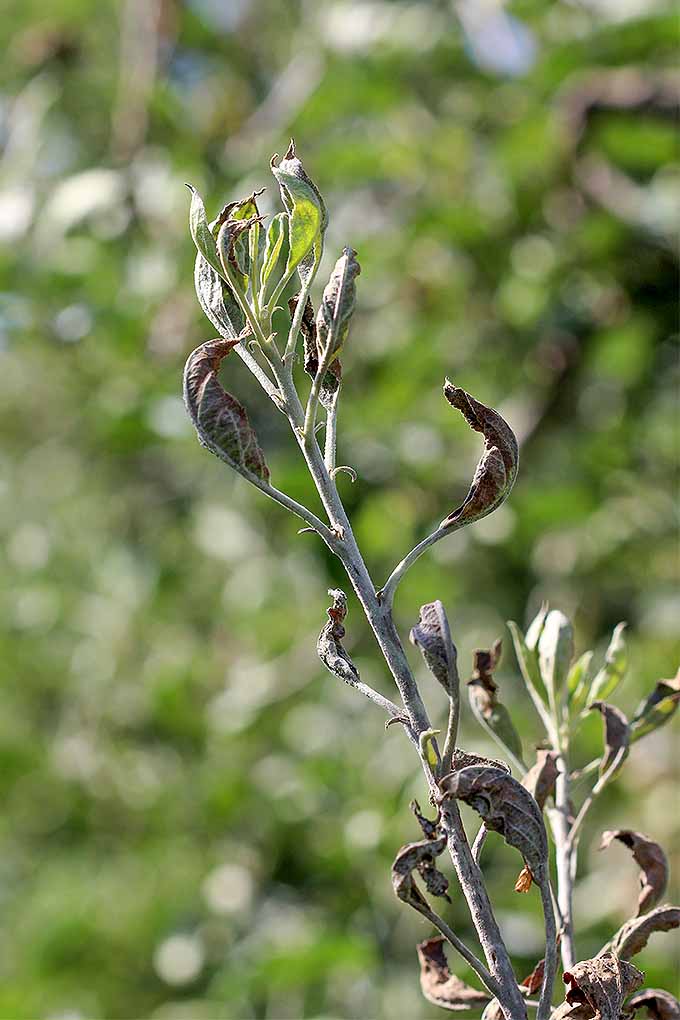
Applying mildew sprays and fungicides is an effective measure against powdery mildew in almost every case.
Read more about combating powdery mildew attacks on apple trees.
Apple Scab
A fungus that affects the leaves and fruit and makes fruit inedible, it can weaken trees and cause them to prematurely lose their leaves. You’ll notice it first on the leaves and then the fruit of a tree as irregular patches.

Apple scab is common during rainy, wet springs and summers. A fungicide is an appropriate solution. The University of Minnesota Extension has an excellent, thorough resource for learning more about apple scab.
Cedar Apple Rust
Another fungal infection, cedar apple rust requires the presence of two different tree species to complete its lifecycle, usually cedars or junipers and apple trees.
Luckily this rust does not often kill the trees, but it does make them unattractive and can ruin crops. Use a fungicide to treat it.
Read more about cedar apple rust here.
Try These Recipes
The best part about homegrown fruit is eating it! Once your trees are thriving, you’re going to have a lot. Here are a few recipes to try:
Every year on my birthday I skip the cake and elect apple pie as my dessert of choice. It’s been a favorite since I can remember. And what’s better than a plate full of pie? A pie you can fit and carry in your hand , of course! Try this recipe from our sister site, Foodal.
A tasty recipe with great portability. I’m looking forward to the next harvest in the fall so I can add some fresh fruit to this delicious dessert.
I also enjoy a tasty cocktail, and adding some fresh fruit to the mix is a great idea. My favorite from Foodal is the “shrub,” a nice addition to my favorite autumnal drinks.
For breakfast, this recipe for a chicken sausage and apple sandwich from The Fitchen has worked its way into my weekly breakfast rotation. On the weekends I’ll even have one more for lunch.
To round out the day, I adore Mexican food. You’ll love the unique and utterly delicious combination of ingredients in this recipe for pulled pork mini tacos with soy glaze and apple carrot slaw from Feast in Thyme.
I’ve made this recipe a handful of times for friends and family with great success. Apples and pork are a pair made for each other, and this taco recipe is a glowing example of why.
How ‘Bout Them Apples?
Ah, delicious apples! The only thing better than eating a good apple is growing your own tree. It’s one of those excellent additions to the yard and garden that provides shade, a strong form, beautiful flowers in the spring, and a delicious crop of edible fruit.
Make it your goal to plant a couple of apple trees this spring. It might take a while before you’re enjoying their fruit, but you’ll remember every bit of planting, pruning, and prep that went into the first juicy bite that you grew yourself.
And for more apple growing tips, check out some of our other guides:
- How to Protect Apple Trees in the Winter
- How to Prevent Soggy Breakdown Disorder in Apples
- How to Prevent Armillaria Root Rot on Apple Trees
Product photos via Jobe’s Organics, Ohhuhu, Truper, Enviro Pro, Anpatio, and Olson Products Inc. Uncredited photos: Shutterstock. With additional writing and editing by Allison Sidhu.
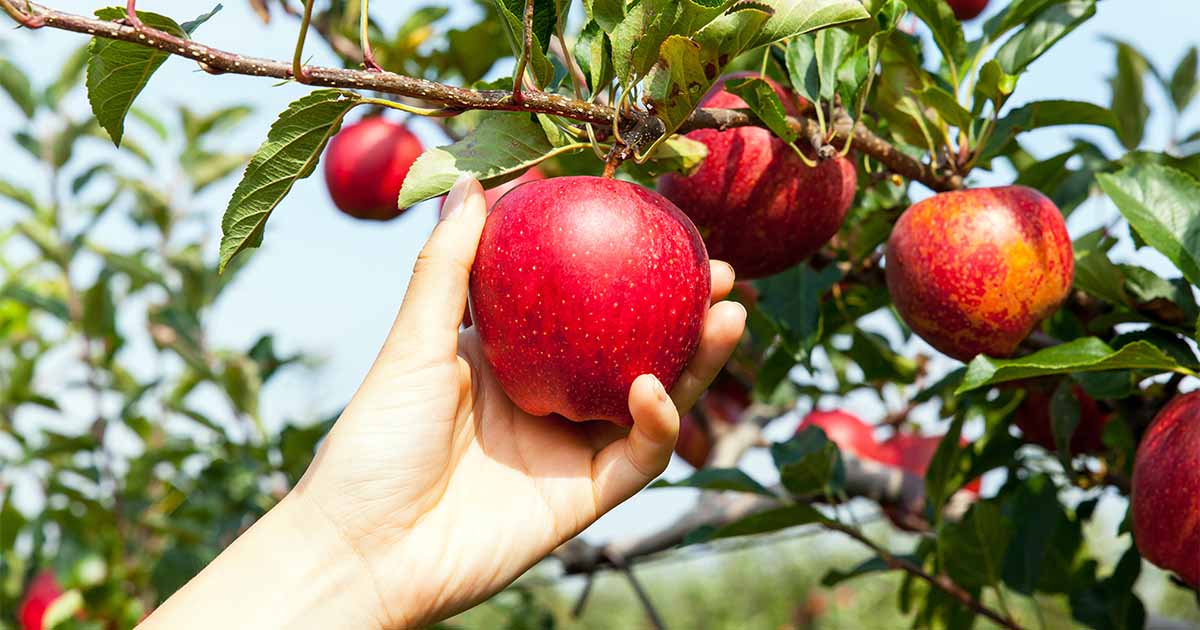
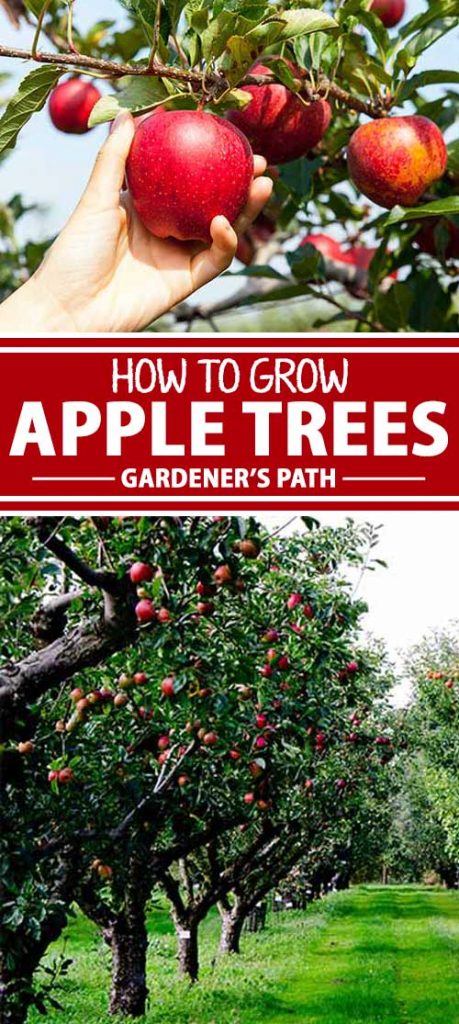
I’ve had a Red Delicious apple tree for about 6-7 years. It has produced hundreds of apples, BUT it has yet to produce one apple that turned red??? If I don’t pick them, or the birds don’t eat them, they will naturally fall off, GREEN. I cannot figure out how to make them turn red. Thinking about chopping the tree down and starting over. Please advise.
If you’ve gotten this far (and you’re a ‘Red Delicious’ fan) please don’t chop that tree down! Where are you located, Michael? About how many hours of sun per day does your apple tree get? And is there a pollinator of another variety with the same bloom phase located in the vicinity? It sounds like your tree is suffering from a combination of several potential issues. First, pruning is key. This is usually done in late winter/early spring when trees are still dormant, to remove dead branches and encourage airflow through the growing season, as well as adequate sun exposure.… Read more »
I have a four year old Macintosh tree which was damaged by rabbits chewing heavily on the trunk. The tree has produced apples over the past three years but because of the damage to the trunk this past year it has less foliage but lots of fruit. As a result of the damage there are new beaches growing from the bottom of the tree. I am wondering if the new growth is taking nutrients from the tree? If so what should I do? Thanks Wallace
I’m so sorry to hear about the rabbit damage, Wallace! It’s unfortunate, but severely damaged young fruit trees will not always recover. Suckering is common in grafted trees, and these suckers are likely coming from the rootstock rather than the Macintosh scion. Putting energy into producing this new growth will sap your tree’s energy, and these should be removed as soon as possible if they’re coming from below the graft union.
In early spring, remove any dead growth from the top of the tree. If new growth does not appear, you’ll have to remove and replace it.
I have a place at Odisha Ganjam, where I want to start apple production. Kindly help me – is this place suitable or not?
Odisha has a hot and humid climate, which can make apple growing difficult, but not impossible. You may be interested in this article that references a farmer who successfully grew ‘Himachal’ type apples there. Look for varieties that require a low number of chill hours to produce fruit, like ‘Gala’ or ‘Tropical Beauty.’ With attentive care, you should be able to bring in a harvest in your region. Good luck!